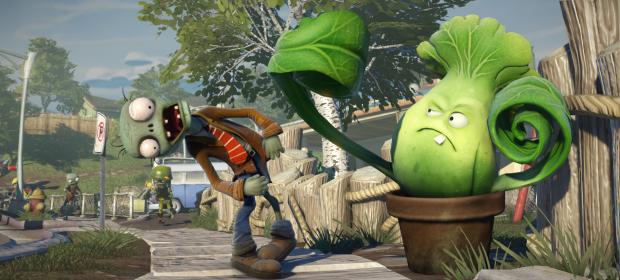You know that feeling of disappointment you get when an actor you idolize lets themselves go? After years of only taking the best roles, they get to the point where they stop caring about the integrity of their brand, or artistic merit, and suddenly it’s all sequels and cameos as they lazily plaster their name on rubbish projects for big money. Well, that’s kind of what I feared had happened when I first heard about Plants VS Zombies: Garden Warfare.
What made Plants Vs. Zombies so compelling was its combination of depth, personality and accessibility – and it was difficult to imagine how any of these strategic gameplay tropes would transfer over to a third person setting at all – let alone competently. Yet, when you pick up that controller, bewilderingly, Garden Warfare does work – and pretty well, at that.
Garden Warfare is a class-based, multiplayer third person shooter, and is PopCap’s first ever 3D console title. They’ve got Garden Warfare running beautifully in the Frostbite 3 engine. The creatures from the PvZ universe have been faithfully and lovingly recreated, and look gorgeous in action on the Xbox One.
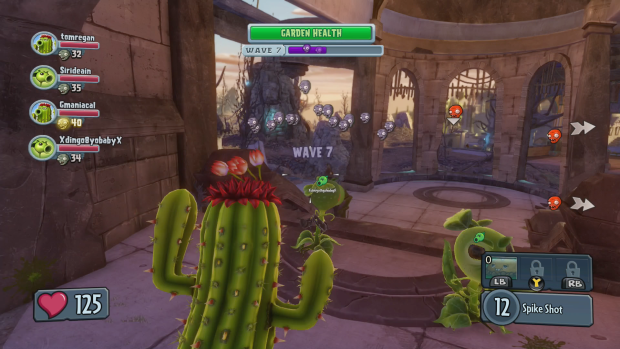
At first glance, the colourful aesthetic may be enough for some to dismiss this game as a serious shooter, but underneath those appealing primary colours lies a unique and surprisingly tactical experience.
The first thing that becomes apparent is that Garden Warfare is very reminiscent of Battlefield, with the main mode taking cues from the latter’s rush mode. Called Gardens and Gravestones here, it sees the two teams (Plants and Zombies) battling over control of various gardens around the map. What makes this mode – and indeed every other mode -interesting, is the variety of amazing abilities at your disposal.
There are four classes you can play as on either side, each with three unique abilities. While each team has an equivalent class, they feel different to one another. This varied roster leads to a huge amount of depth and differing play styles in Garden Warfare, and makes the game more tactical than you’d imagine.
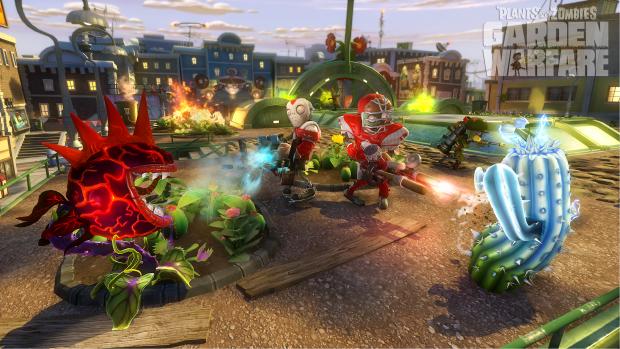
The Pea Shooter is the balanced run and gun class, and his primary weapon fire is slow and deliberate, but packs a punch like a grenade launcher. The Pea Shooter class comes with three great abilities that lend themselves to both long distance fragging and close quarter combat, the first of which being the explosive chilli bean bomb. Functioning as a high damage grenade, the chilli bean can be dropped at close range to inflict high damage on any zombie players close by, and is a great way to save your skin when surrounded by the enemy.
For more long distance players, the “gatling pea” ability has you covered. Turning you into a stationary assault turret, setting this up in the right place can quickly turn the tide of battle and rack up a grin-inducing number of kills in record time. It also gives the Pea Shooter an army helmet, which is admittedly pretty adorable. This class’s final ability, Hyper, lets it dash around like a kid with a sugar high, and can also be used to propel your jumps to heights of gnarly proportions – which mainly leads to players finding tall camping spots.
The zombie all rounder, the Soldier, is the Pea Shooter’s equivalent – yet has a fairly different set of abilities. Armed with a one shot kill rocket launcher, the wonderfully named “zombie stink cloud”, and the ability to leap incredibly high into the air, he compliments the rest of his team’s abilities perfectly.
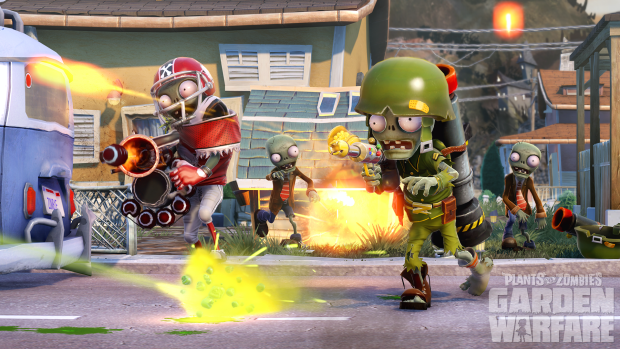
Healing classes on each team offer different support abilities, while keeping the same core role on their respective teams. While the Plants’ sunflower class can heal individual units as well laying down area of effect healing, the zombie scientist can only heal allies within an area of effect. Because of this, the scientist is armed with a shotgun and has the ability to teleport a few feet, making its up close and personal playstyle a stark contrast to the sunflower’s long distance weaponry.
This variation makes everything feel unique, and is a major plus point for the tactical combat. However, one of the most inspired abilities in the game comes from The Cactus class, who has the ability to deploy a controllable garlic drone and deal death from above. There is little in gaming as humiliating as being gunned down by a piece of flying garlic, and it feels great to be at the helm of it. The zombie’s Engineer class flies around on a high-speed drill and has a similar drone ability, but sadly it’s not nearly as charming.
Thankfully, the maps are varied and well designed, if unremarkable, but the open-ended routes to each objective and the visually appealing aesthetic are welcome design choices. Each class levels up as you use it, and ranking up earns you unlockable boosts to your abilities. These are made up of the usual shooter perks, and do things such as increase ammo capacity and reduce reload speed.
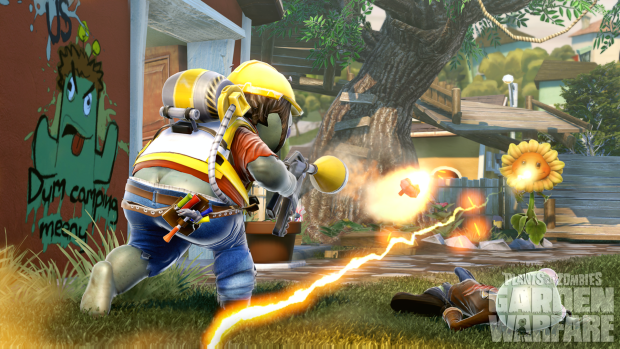
Your progress with the Plant classes carry over to the four player, Horde-inspired Garden Ops mode. Facing off against waves of increasingly silly looking zombies is great fun, and the addition of plant pots where you can lay defences is a knowing nod to the tower defense roots.
It’s not just the surprisingly well-designed gameplay that keeps you invested in Garden Warfare, though – it’s also the little touches. The ding you are greeted with each time you kill an enemy is hugely satisfying. The pure simplicity is genius, and you’ll find yourself feeling elated when you’re gifted with a few audible rewards after a multi-kill.
The decision to make this game third person was a smart one, as being able to see the ridiculous character you’re playing as helps to give Garden Warfare much of its personality. As you progress through the game you unlock upgrades for the classes, but more importantly, dress up items for your characters, which vary from handlebar moustaches to dodgy tattoos.
Sadly, the two main game types and a horde mode feels a little meagre in this day and age, and one extra mode would have gone a long way to making Garden Warfare feel like a more fleshed-out package. The lack of story mode is particularly disappointing, as the gameplay and design lend themselves perfectly to a co-op campaign, and hopefully this is something we will see in future entries.
VERDICT: Garden Warfare is different enough to compliment those long sessions of other online shooters, and acts as a great palette cleanser in a genre dominated by greys and browns that often takes itself far too seriously. The inclusion of local multiplayer is also a huge plus and, depending on how often you play with family and friends, can add much to the value.
Against all odds, somehow the team at PopCap have managed to craft a fun shooter that remains true to the series. More commendably, they’ve created a shooter that takes you by surprise and makes you laugh.
 VERY GOOD. An 8/10 is only awarded to a game we consider truly worthy of your hard-earned cash. This game is only held back by a smattering of minor or middling issues and comes highly recommended.
VERY GOOD. An 8/10 is only awarded to a game we consider truly worthy of your hard-earned cash. This game is only held back by a smattering of minor or middling issues and comes highly recommended.
Review code received at day-long review event.


